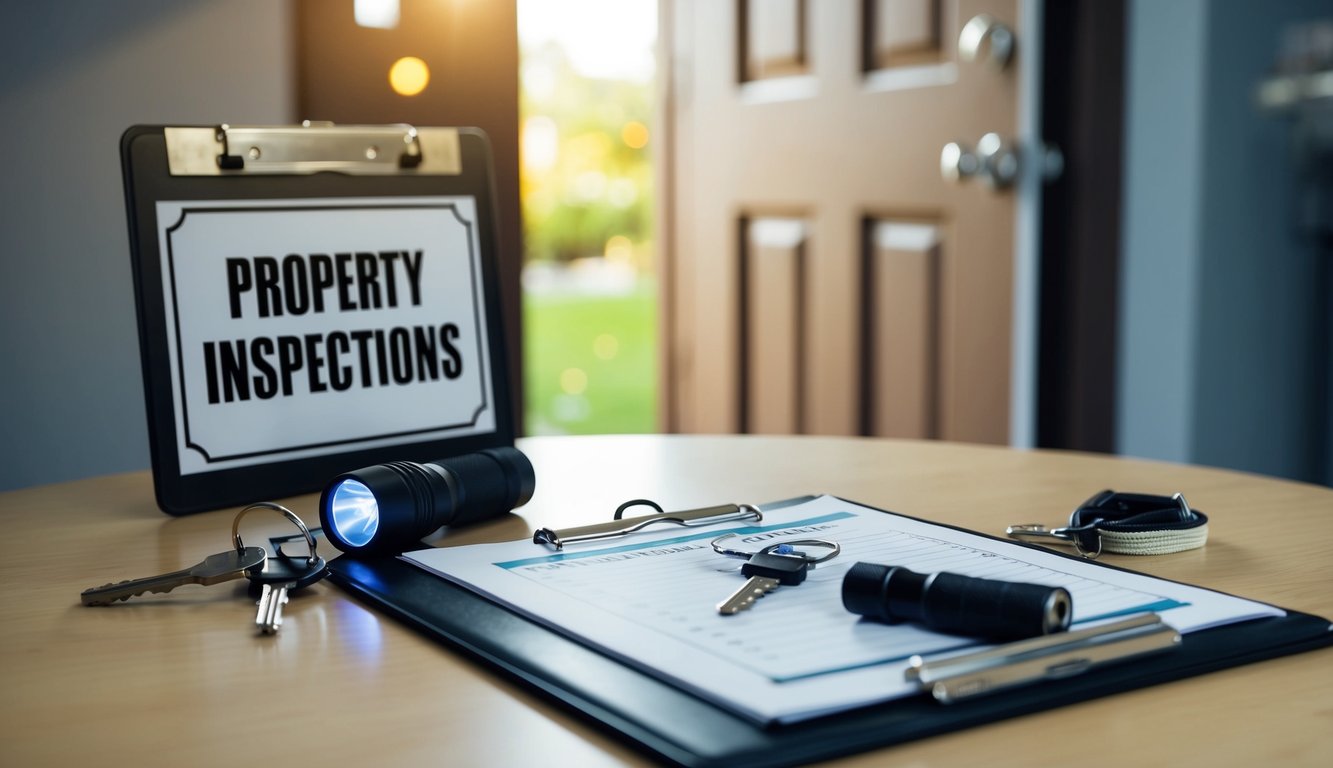Navigating the world of property inspections as a real estate investor requires a different approach than what homebuyers typically experience. While homebuyers focus on the property as a place to live, investors need to evaluate properties through the lens of profitability, tenant safety, and long-term sustainability. A comprehensive rental property inspection helps investors identify potential maintenance issues, safety hazards, and code violations that could impact both tenant satisfaction and your return on investment.
When acquiring new investment properties or maintaining existing ones in your portfolio, understanding these critical differences can save you thousands in unexpected repairs and legal complications. Licensed property inspectors can provide detailed assessments of structural aspects, heating systems, and other essential components that might affect your property’s performance. Regular inspections also establish a documented history of the property’s condition, which proves invaluable during tenant transitions.
Key Takeaways
- Property inspections for rental investments focus on profitability metrics and maintenance forecasting rather than personal livability factors.
- Regular, documented inspections protect your investment by identifying small issues before they become expensive emergency repairs.
- Understanding legal boundaries and tenant rights regarding property access and inspection procedures prevents costly disputes.
Understanding The Key Differences
Property inspections vary significantly depending on their purpose and who conducts them. As a real estate investor, you need to recognize these distinctions to protect your investments.
Rental Property Inspections vs. Home Buyer Inspections
Rental property inspections focus on overall condition and potential damage, whereas home buyer inspections thoroughly examine structural integrity and systems functionality. Your rental inspections typically check for tenant-caused issues, while buyer inspections look for pre-existing problems.
Different Goals and Focuses:
| Inspection Type | Primary Goal | Key Focus Areas |
|---|---|---|
| Investor Rental | Maintain asset value | Tenant compliance, property condition, preventative maintenance |
| Home Buyer | Identify defects | Structural issues, major systems, safety concerns |
When purchasing an investment property, you should request a comprehensive inspection that evaluates both structural elements and rental viability. This dual approach helps you make an informed decision about potential returns versus maintenance costs.
Frequency Considerations:
For your investment properties, inspections should occur more frequently than with owner-occupied homes. Most successful investors conduct:
- Pre-purchase inspections
- Move-in and move-out inspections
- Quarterly or semi-annual routine inspections
- Annual comprehensive evaluations
Property inspections for rentals often check for overgrown lawns, property damage, and overall condition. Your focus should be on identifying issues that could affect property value or tenant satisfaction.
When To Conduct Rental Property Inspections
Strategic timing of property inspections is crucial for real estate investors to protect their assets and maintain property value. Knowing the right moments to schedule these evaluations helps you stay proactive rather than reactive.
Move-in inspections should be conducted before your tenant takes possession of the property. Document the current condition with photos and a detailed checklist that both you and the tenant sign to avoid disputes later.
Routine periodic inspections typically occur quarterly or bi-annually. These help you identify maintenance issues before they become expensive problems. Remember to provide tenants with 24 to 48 hours notice before conducting these inspections.
Move-out inspections are essential when tenants vacate the property. Compare current conditions against the move-in documentation to determine appropriate security deposit deductions.
Seasonal inspections can prevent weather-related damage. Schedule these before extreme seasons—checking HVAC systems before summer, inspecting pipes before winter, etc.
Emergency inspections may be necessary after severe weather events or when you suspect lease violations.
For investors dealing with properties in foreclosure, conducting default inspections becomes critical. These specialized assessments help identify the condition of distressed properties before acquisition.
Default inspections also provide valuable information about necessary repairs and renovations, helping you calculate accurate investment returns before purchasing foreclosed properties.
Always verify local laws regarding landlord inspection rights in your jurisdiction. Most states have specific requirements about notice periods and acceptable inspection frequency.
Creating Your Rental Property Inspection Checklist
A comprehensive property inspection checklist is essential for maintaining your investment properties in optimal condition. Your checklist should be thorough enough to catch potential issues before they become costly problems.
Start by documenting basic information including the property address, inspection date, and the names of everyone present during the inspection. This creates a clear record for your files.
Interior Inspection Items:
- Walls, ceilings, and floors (cracks, water damage, structural issues)
- Windows and doors (functioning locks, broken glass, weather stripping)
- Plumbing fixtures (leaks, water pressure, drainage)
- Kitchen and bathroom condition
- Smoke and carbon monoxide detectors
Exterior Inspection Items:
- Roof and gutters (missing shingles, blockages)
- Siding and exterior paint
- Foundation (cracks or shifting)
- Landscaping and drainage
- Driveways, walkways, and steps
The systems and appliances in your rental require thorough checking. Test the HVAC system, water heater, major appliances, electrical outlets, and plumbing fixtures to confirm proper operation.
When conducting a rental property walk-through, take detailed photos of any issues discovered. These visual records protect you and provide clear documentation of property conditions.
Many municipalities have specific rental inspection requirements you must follow. Research local regulations to ensure your checklist addresses all legally required elements.
Consider using digital inspection tools to streamline the process. Many property management platforms offer mobile apps that allow you to complete inspections on-site and automatically generate reports.
Red Flags To Watch For During Rental Inspections
As an investor, identifying problems early during property inspections can save you thousands in future repair costs. Regular inspections help you maintain property value and prevent small issues from becoming major expenses.
Unauthorized Occupants or Pets: Watch for signs of hidden pets like pet hair, food bowls, or scratches on doors. Extra toothbrushes or clothing may indicate unauthorized residents living in the unit.
Water Damage and Mold: Look for discoloration on walls, ceilings, or around windows. Musty odors or visible mold growth require immediate attention as they present serious health risks and can lead to costly remediation.
Structural Integrity Issues: Cracks in foundations, uneven floors, or doors that don’t close properly may indicate settling problems. These issues can compromise the safety of your investment property and lead to expensive repairs.
Electrical System Problems: Outlets with burn marks, flickering lights, or overloaded circuits present fire hazards. Check that tenants haven’t made dangerous DIY modifications to the electrical system.
Heating System Deficiencies: Malfunctioning heating systems can lead to uncomfortable living conditions and potential lease violations. Ensure all components are functioning properly.
Environmental Hazards: Older properties may contain asbestos or lead paint. These materials are harmless when undisturbed but can become dangerous when damaged. Document any deterioration immediately.
Pest Infestations: Evidence of rodents, termites, or other pests requires swift action. Look for droppings, chewed materials, or visible termite damage which can undermine structural integrity.
Poor Maintenance Practices: Signs of neglect like excessive dirt, damaged fixtures, or cluttered areas may indicate tenants who aren’t treating your property with care.
Legal Considerations For Rental Property Inspections
As an investor, understanding the legal framework surrounding rental property inspections is crucial to avoid potential disputes and lawsuits. Proper notice is not just a courtesy—it’s a legal requirement in most jurisdictions.
Notice Requirements:
- Most states require 24-48 hours written notice before entry
- Some jurisdictions extend this to 72 hours or more
- Emergency situations may permit entry without notice
- Always document your communication about inspection timing
Entering a property without proper notice can be considered trespassing, regardless of your ownership status. Legal action could result from improper entry procedures.
Your tenants maintain privacy rights even though you own the property. During inspections, you cannot go through personal belongings or open cabinets, drawers, or other private storage areas. Choosing to examine a tenant’s belongings can lead to serious legal consequences.
Documentation Best Practices:
- Take dated photographs of property conditions
- Maintain written records of all inspections
- Have a standardized inspection checklist
- Provide tenants with inspection results
It’s generally recommended to conduct routine inspections two to three times during the lease period, depending on your property type. These checks help you maintain the property’s condition while respecting tenant rights.
Remember that inspection laws vary significantly by location. What’s permissible in one municipality may violate ordinances in another, potentially resulting in a notice of violation from local authorities.
Best Practices For Effective Rental Property Inspections
Regular property inspections are crucial for protecting your investment. Scheduling inspections every six to eight months is ideal, though at minimum, conduct them annually.
Communication Is Key Always provide proper notice before inspections. Most areas require at least 12-24 hours’ notice to tenants. Clear communication builds trust and reduces tension during the inspection process.
Leverage Technology Use digital inspection tools to streamline your process. Property management apps allow you to document conditions with photos, create detailed reports, and store everything securely in the cloud.
Create a Consistent Schedule Follow this inspection timeline for best results:
| Inspection Type | Timing | Purpose |
|---|---|---|
| Move-in | Before tenant occupancy | Document initial condition |
| Routine | Every 6-8 months | Preventive maintenance |
| Move-out | After tenant vacates | Assess damages and repairs |
Thorough Documentation Take detailed notes and photos during each inspection. Maintaining good records helps track property conditions over time and provides evidence if disputes arise.
Follow-Up Procedures Address maintenance issues promptly after inspections. Prioritize repairs based on urgency and communicate timelines clearly to your tenants.
Respect Boundaries Focus only on property condition and safety issues during inspections. Review your lease agreement and local laws beforehand to ensure compliance with tenant privacy rights.
How Regular Inspections Protect Your Investment
Regular property inspections are one of the most powerful tools in a real estate investor’s arsenal. By conducting routine rental inspections, you create a proactive approach to property management that safeguards your financial interests.
When you inspect regularly, you can identify small maintenance issues before they develop into major problems. A minor plumbing leak caught early might cost $200 to fix, while the same issue left unattended could result in thousands of dollars in water damage and mold remediation.
Property inspections also help maintain your property’s value over time. By documenting the condition of your investment and addressing wear and tear promptly, you prevent the gradual depreciation that neglected properties experience.
Your liability exposure decreases significantly with consistent inspections. Identifying safety hazards—like loose railings or faulty electrical systems—allows you to address them before accidents occur, potentially saving you from costly lawsuits.
Key Benefits of Regular Inspections:
- Early detection of maintenance issues
- Preservation of property value
- Reduced emergency repair costs
- Minimized liability risks
- Documentation for insurance purposes
Regular inspections also foster better relationships with tenants. When you demonstrate care for the property through scheduled inspections, tenants often respond with greater respect for your investment.
Professional property managers recommend quarterly inspections as the sweet spot—frequent enough to catch issues early but not so frequent as to inconvenience tenants.
FAQs
Can I inspect the rental property myself?
While you can perform basic inspections yourself, professional inspectors have specialized training to identify issues you might miss. For investment properties, professional inspections provide documentation that can be valuable for insurance, taxes, and potential disputes.
How much does a rental property inspection cost?
Inspection costs vary based on property size, location, and scope of inspection. Most rental property inspections range from $300-$500, with multi-unit properties costing more. Consider this expense an investment protection rather than just another cost.
How often should I inspect my rental properties?
Most investment property experts recommend conducting inspections quarterly or semi-annually. Regular inspections help identify maintenance issues before they become expensive problems and demonstrate your commitment to property upkeep.
Should I attend the inspection?
Yes! Attending the inspection allows you to ask questions directly and gain insights about your investment property. This firsthand knowledge helps you better understand maintenance priorities and potential future expenses.
What documentation should I maintain from inspections?
Keep detailed records including:
- Inspection reports with photos
- Maintenance recommendations
- Cost estimates for repairs
- Timeline of completed work
- Communication with tenants about findings
These records protect your investment and provide documentation for tax purposes, insurance claims, and tenant discussions about property conditions.
Ready to maximize your rental property’s true potential?
Never miss a rent increase opportunity again! Get real-time alerts and market updates from RentCast.io and save 20% with promo code BIGDEAL.

Discover the secret to stress-free property management with How To Find & Keep Great Tenants. This essential guide reveals proven strategies for attracting high-quality renters and creating long-term, mutually beneficial relationships.
But finding great tenants is only half the battle. Uncover the art of tenant retention, from creating a positive living environment to addressing concerns promptly and professionally.
With this book, you’ll transform your rental property into a sought-after home that tenants won’t want to leave. Minimize vacancies, reduce turnover costs, and maximize your investment’s potential by mastering the skills to find and keep exceptional tenants.
Get your copy now from your favorite bookseller:
- Amazon (non-Premium Edition, does not include Investment Real Estate Analysis: A Case Study, available in paperback only)
- Books2Read for Apple, Barnes & Noble, Kobo, Scribed, and 8 more sellers with both eBook and paperback options available (Premium Edition)
- Payhip as a downloadable PDF (Premium Edition)
Ready to take your business to the next level?
- Subscribe to our newsletter
- Visit the learning center
- Learn more about our consulting services
This blog post was created by J. Scott Digital content creation services.



